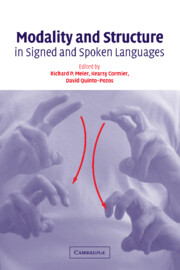Book contents
- Frontmatter
- Contents
- List of figures
- List of tables
- List of contributors
- Acknowledgements
- 1 Why different, why the same? Explaining effects and non-effects of modality upon linguistic structure in sign and speech
- Part I Phonological structure in signed languages
- Part II Gesture and iconicity in sign and speech
- 7 A modality-free notion of gesture and how it can help us with the morpheme vs. gesture question in sign language linguistics (Or at least give us some criteria to work with)
- 8 Gesture as the substrate in the process of ASL grammaticization
- 9 A crosslinguistic examination of the lexicons of four signed languages
- Part III Syntax in sign: Few or no effects of modality
- Part IV Using space and describing space: Pronouns, classifiers, and verb agreement
- Index
- References
9 - A crosslinguistic examination of the lexicons of four signed languages
Published online by Cambridge University Press: 22 September 2009
- Frontmatter
- Contents
- List of figures
- List of tables
- List of contributors
- Acknowledgements
- 1 Why different, why the same? Explaining effects and non-effects of modality upon linguistic structure in sign and speech
- Part I Phonological structure in signed languages
- Part II Gesture and iconicity in sign and speech
- 7 A modality-free notion of gesture and how it can help us with the morpheme vs. gesture question in sign language linguistics (Or at least give us some criteria to work with)
- 8 Gesture as the substrate in the process of ASL grammaticization
- 9 A crosslinguistic examination of the lexicons of four signed languages
- Part III Syntax in sign: Few or no effects of modality
- Part IV Using space and describing space: Pronouns, classifiers, and verb agreement
- Index
- References
Summary
Introduction
Crosslinguistic and crossmodality research has proven to be crucial in understanding the nature of language. In this chapter we seek to contribute to crosslinguistic sign language research and discuss how this research intersects with comparisons across spoken languages. Our point of departure is a series of three pair-wise comparisons between elicited samples of the vocabularies of Mexican Sign Language (la Lengua de Señas Mexicana or LSM) and French Sign Language (la Langue des Signes Française or LSF), Spanish Sign Language (la Lengua de Signos Española or LSE), and Japanese Sign Language (Nihon Syuwa or NS). We examine the extent to which these sample vocabularies resemble each other. Writing about “sound–meaning resemblances” across spoken languages, Greenberg (1957:37) posits that such resemblances are due to four types of causes. Two are historical: genetic relationship and borrowing. The other two are connected to nonhistorical factors: chance and shared symbolism, which we here use to mean that a pair of words happens to share the same motivation, whether iconic or indexic. These four causes are likely to apply to sign languages as well, although – as we point out below – a genetic linguistic relationship may not be the most appropriate account of the development of three of the sign languages discussed in this chapter: LSF, LSM, and LSE.
The history of deaf education through the medium of signs in Mexico sheds light on why the three specific pair-wise comparisons that form the basis of this study are informative.
Information
- Type
- Chapter
- Information
- Modality and Structure in Signed and Spoken Languages , pp. 224 - 236Publisher: Cambridge University PressPrint publication year: 2002
References
Accessibility standard: Unknown
Why this information is here
This section outlines the accessibility features of this content - including support for screen readers, full keyboard navigation and high-contrast display options. This may not be relevant for you.Accessibility Information
- 21
- Cited by
